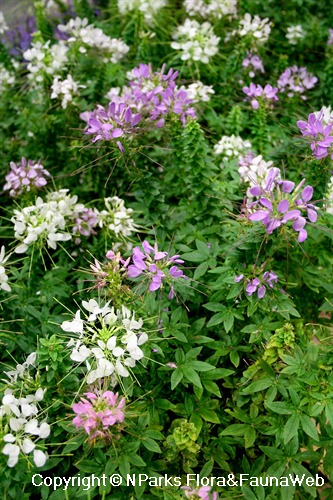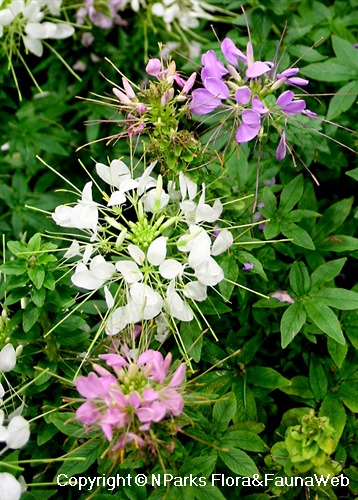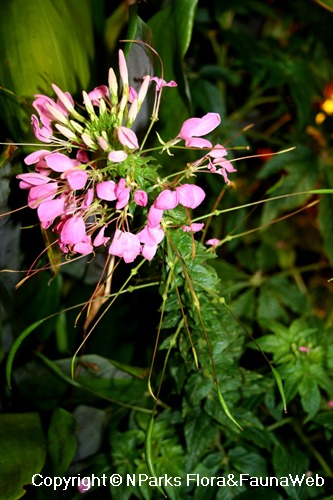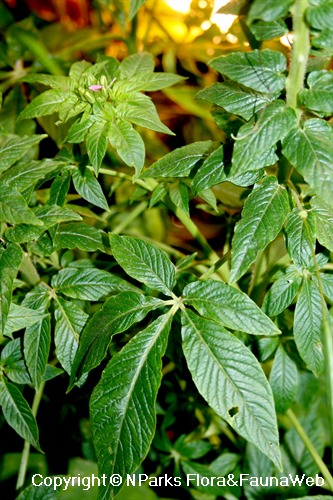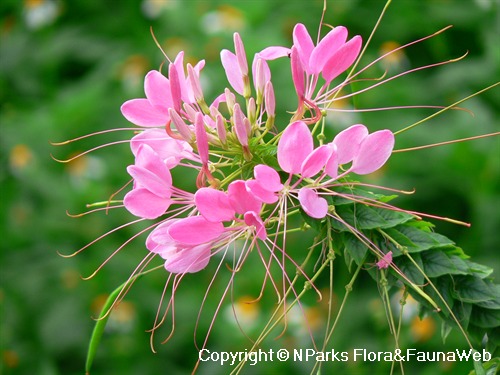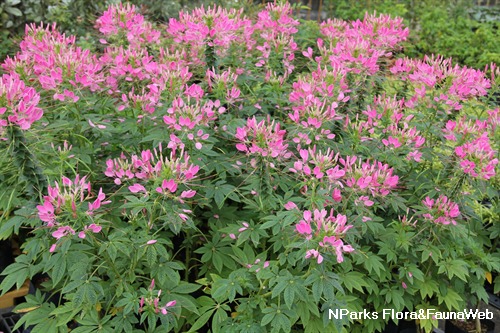
Back
Tarenaya houtteana (Schltdl.) Soares Neto & Roalson
| Family Name: | Cleomaceae |
| Synonyms: | Cleome hassleriana Chodat |
| Common Name: | Spider Flower, Spider Plant, Grandfather's Whiskers |
Name
Classifications and Characteristics
| Plant Division | Angiosperms (Flowering Seed Plants) (Dicotyledon) |
|---|---|
| Plant Growth Form | Herbaceous Plant |
| Lifespan (in Singapore) | Perennial |
| Mode of Nutrition | Autotrophic |
| Plant Shape | Shrubby |
| Maximum Height | 0.9 m to 1.8 m |
| Maximum Plant Spread / Crown Width | 0.3 m to 0.6 m |
Biogeography
| Native Distribution | Brazil to Northern Argentina |
|---|---|
| Native Habitat | Terrestrial |
| Preferred Climate Zone | Tropical |
| Local Conservation Status | Non-native (Horticultural / Cultivated Only) |
Description and Ethnobotany
| Growth Form | It is an herbaceous plant that often grows 0.9 - 1.2 m tall, but sometimes up to 1.5 - 1.8 m tall. |
|---|---|
| Foliage | Leaves are palmately compound, sticky and may have unpleasant odours. There is a pair of spines at the base of the leaf stalk. Some cultivars lack both odour and spines. |
| Flowers | Flowers in dense terminal raceme inflorescences, showy pink, lavender or white petals, long thread-like stamens, attract bees and butterflies. |
| Fruit | Fruit are long thin capsules (15 cm by 3 mm), many-seeded, brown and dehiscent when mature. Seeds are round, brown and bumpy. |
| Cultivation | It grows best under full sun and in moist, well-drained soil. Although it may tolerate light shade, shade will cause the plant to grow taller and become less stable. Prune off side-shoots for tall slender plants or remove central bud when plant is 30 cm tall for a shorter, bushier form. Under hot and humid growing conditions, the plant may develop powdery mildew or rust. Remove spent flowers to prolong flowering. Propagate by seed. |
Landscaping Features
| Desirable Plant Features | Ornamental Flowers |
|---|---|
| Landscape Uses | Flowerbed / Border |
| Thematic Landscaping | Butterfly Garden |
| Usage Hazard - Cons | Spines/Thorns - Stem/Branch |
| Usage Hazard - Cons Remarks | Spines on thick stems at leaf bases. Leaves are resinous and slightly sticky to the touch. |
Fauna, Pollination and Dispersal
| Fauna Pollination Dispersal Associated Fauna | Bat Food (, Flower Nectar), Bee-Attracting, Butterfly-Attracting (Flower Nectar) |
|---|---|
| Pollination Method(s) | Biotic (Fauna) (Vertebrates (Bat), Insects (Bee), Insects (Butterfly, Moth)) |
| Seed or Spore Dispersal | Abiotic (Explosive Dehiscence) |
Plant Care and Propagation
| Light Preference | Full Sun |
|---|---|
| Water Preference | Moderate Water |
| Plant Growth Rate | Fast |
| Rootzone Tolerance | Fertile Loamy Soils, Well-Drained Soils, Easy to Grow |
| Pruning | Prune side-shoots to get tall slender plant. When plant is 30cm tall, prune central bud to encourage branching, & to get shorter and bushier form. |
| Propagation Method | Seed |
| Propagule Establishment Remarks | Seed leaves spoon-shaped. True leaves palmately-lobed. Seeds sowed outdoors germinate in 28-45 days. |
| Maintenance Requirements Remarks | Remove spent flowers to prolong flowering period. |
| Planting Distance | 0 |
Foliar
| Foliage Retention | Evergreen |
|---|---|
| Mature Foliage Colour(s) | Green |
| Mature Foliage Texture(s) | Sticky, Raised / Sunken Veins |
| Foliar Modification | Spine (axillary) |
| Foliar Type | Compound (Palmate) |
| Foliar Arrangement Along Stem | Alternate |
| Foliar Attachment to Stem | Petiolate |
| Foliar Shape(s) | Non-Palm Foliage (Palmate) |
| Foliar Venation | Palmate |
| Foliar Margin | Palmately Lobed, Entire |
| Foliar Apex - Tip | Acute |
| Foliar Base | Acute |
| Typical Foliar Area | Microphyll ( 2.25cm2 - 20.25 cm2 ) |
Non - Foliar and Storage
| Stem Type & Modification | Herbaceous |
|---|---|
| Root Type | Underground (Fibrous Root) |
Floral (Angiosperm)
| Flower & Plant Sexuality | Bisexual Flowers |
| Flower Colour(s) | Pink, White, Purple |
|---|---|
| Flower Grouping | Cluster / Inflorescence |
| Flower Location | Terminal |
| Flower Symmetry | Bilateral |
| Inflorescence Type | Raceme |
| Flowering Opening Time | Time-Independent |
| Flower Size | 3 cm |
| Inflorescence Size | 18 cm |
Fruit, Seed and Spore
| Mature Fruit Colour(s) | Brown |
|---|---|
| Fruit Classification | Simple Fruit |
| Fruit Type | Dehiscent Dry Fruit , Silique |
| Mature Seed Colour(s) | Brown |
| Mature Seed Texture(s) | Bumpy / Tuberculate |
Image Repository
Others
| Master ID | 7720 |
|---|---|
| Species ID | 3313 |
| Flora Disclaimer | The information in this website has been compiled from reliable sources, such as reference works on medicinal plants. It is not a substitute for medical advice or treatment and NParks does not purport to provide any medical advice. Readers should always consult his/her physician before using or consuming a plant for medicinal purposes. |

